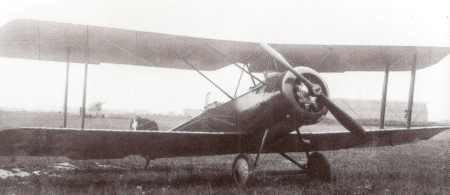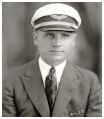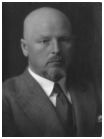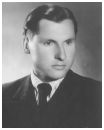A Struggle with Death
On February 5, 1919, during a battle with the Bolsheviks, the Lithuanians captured a Red Army Sopwith "1 1/2 Strutter," which became Lithuania's first combat plane, though it was not used until August 3, 1921. On September 21, 1928, during a flight over Kaunas, the plane's engine caught fire. The pilot, Captain Leonardas Peseckas (1899-1976) and Lieutenant Kazys Šimkus (1905-1968) climbed out onto the wings, when Peseckas continuously shifted his weight about in order to maintain the plane's balance. He successfully landed the plane, and although he was severely burned managed to sea t his co-pilot's life and his own. In recognition of such a brave feat the President of the Republic of Lithuania bestowed the rank of major on L. Peseckas. Below, Leonardas Peseckas recalls that fateful day:
A Sopwith plane has been standing in the Kaunas hangar since March 1919. Our infantry took it from the Bolsheviks near Jieznas, and it was considered Lithuania's first combat plane. My introduction to that plane was my first introduction to aviation. It was in fact a peculiar machine. It had a star motor that spun together with the propeller. It did not have a fuel handle but instead, near the steering column, there was a button, with which one could either cut off the fuel supply or open it completely. In that way, the plane barely having started, the motor would already be working at full capacity. One pushes the button to reduce capacity, and the motor spins from inertia even though it's empty. When it begins to stop, one releases the button again. And so, the button was continuously pushed on and off.
 Sopwith "1 1/2 Strutter," the first Lithuania combat plane.
Sopwith "1 1/2 Strutter," the first Lithuania combat plane.The plane was not being used. It was abandoned and alone, as if it had been forgotten. Later it was repaired. The first one to fly it then was our aviation instructor, who had graduated from an English school, and was the oldest Lithuanian pilot. Captain Hiksa. He flew the plane, as did Darius and I. We could all see that it was unfit for military purposes, and the Sopwith was returned to the hangar, where it remained. in 1928 some Latvian pilots visited os. Colonel Indians, military attache and a pilot,, had found out that we had a Sopwith. Colonel Indans had flown an English plane of that type. He wanted to experience once again the peculiar thrill of flying a plane with a spinning motor and requested permission from our heads of aviation who granted permission with great pleasure. The plane was once again brought out from the hangar, the motor and controls were checked. The Sopwith was prepared for flight seriously and carefully.
The plane belonged to the 4th Air Squadron. At the time I was the squadron commander, and I was to test the plane in the air and then let Colonel Indans fly it. I boarded the Sopwith on a lovely afternoon. The motor hummed in a thin, tinny voice reminiscent of a bee's buzzing. It was working well. I turned it off and got out to prepare for the flight. At the same time, a young lieutenant, Kazys Šimkus, approached and asked if he could take a flight together with me. Though I hadn't intended to take anyone along, I agreed. Soon we were aloft in the Sopwith. For a half-hour, at an altitude of 500 meters, we did some turns. AH of Kaunas was bathed in sunlight, each building was clearly and sharply visible. The machine hovers in the air—the motor sounds steady and clean. I am seated under one wing, almost on the floor with my legs outstretched. In the second seat, about 1.5 meters away from me is Lt. Šimkus who is glancing around at the sights below. I begin to fly toward the aerodrome, where along one edge there is a row of haystacks. In those days the Kaunas aerodrome was not very large, andupon my approach there were 4 or 5 LVG planes lining up for takeoff, leaving no room to land. I release the button, make a turn and circle once around while waiting to land. Our altitude is 500 meters. I approach again preparing to land—the aerodrome is directly ahead—and, as is always the case, I survey everything with extra care during a landing.
Suddenly, there is a loud explosion in front of me, from inside the motor. I look and listen for a fraction of a second. In that same instant, a blinding flame shoots between my legs, envelops me, then forces its way out, searing my face.
It becomes hot and stuffy. Pennants of flame leap and grow in the blink of an eye, I sit enveloped and feel the flames licking my face. This sudden and unexpected tragic explosion and fire on board is horrifying in the first seconds. As I now recall, my first thought was: "You've finally met your end...how meaninglessly and unnecessarily you perish...the heat is unbearable." Everything was covered in flames. Instinctively. I undo the belts, disengage the magnets and stand up. Images of friends who have died, Vytautas Rauba and Juozas Kumpis, as well as my own life flash before my eyes. It all happened so quickly—it didn't even take one tenth of a second—but in that time I see my life's entire path.
The red, angry fire overcomes me, and I cannot bear the heat. I feel that my whole body has become as hot as the flame itself. I am going to jump. I cannot stand it anymore. (There were no parachutes in those days.) I climb out onto the wing very quickly. My decision to leave the plane and jump to the ground is firm. It is better to die falling 500 meters than to be cooked in this fire. My clothing, legs and gloves are on fire. I ignore it, however. Soon none of it will matter. I am on the edge of the right wing. I lean downward with my back to the motor. The end is near!..
Then I see that without the pilot's guiding hand the flaming tail of the plane is falling, as the nose rises. Below, I see the sad, dark streets of the Old Town, some wooden shacks, and a sparkling stretch of water beyond them. The heavy view below halts me. I have 300 meters. A thought shoots out like the sparks from my burning clothing, which fly through the air into space: should I jump and kill myself in this wreck? This is too meager a grave!
I hold myself back. Again a thought. The fuel tank will soon explode. The plane will be torn apart in the blink of an eye. But maybe? This tiny hope hits me like a beckoning to live. Just maybe, I will break off along with the wing and survive. Somewhere I heard something about gliding. I grab onto this feeble hope as if it were the hand of an unknown rescuer. A miracle! Maybe I can make use of such a miracle.
I hold on to the plane with a firm grip, turning my body around. The flame roars and its red tongues jump from my seat, each one higher than the other. Suddenly I see Kazys Šimkus. He is up from his seat. His eyes are open wide, and the flame is shooting in his direction. He leans over the edge of the cockpit as if to jump. He too, cannot bear the heat any longer. He has also chosen a quicker death. I can see that his leather jacket has caught on the machinegun wheel. He, half leaned over, is moving about, trying to free himself. His jacket having caught saves his life. I shout to him: "Don't jump! You'll kill yourself!" He turns toward me and sees me. He is able to free his jacket, quickly climbs over the cockpit and stands on the other wing. The flames separate us, and I can no longer see him. It is all happening in the blink of aneye, but I feel everything. The plane has completely upended and it seems to stop in midair for a moment. Corkscrew? Then we are both finished. Again, from somewhere in my consciousness a quick decision arises. I must turn the nose so the plane can glide! Thee we can avert the death spiral I lunge to the front of the wing. I climb through the steel bands between the wings. I grab on to them and hang my body in the air. I wait...
As if on a swing, the plane glides forward, I hurry to raise myself up and back with my arms. I have to stop the nosedive. I end up at the middle of the wing. I bend my body back, thinking: "I can save myself like this!"
I balance with my body5 keeping the plane from veering too much in any direction.
I feel It responding to my body movements, The feel tank—again, a sad, dark reality.
Shuddering, I look at it. Columns of fire are all around. If it explodes, that is the end of our story.

I see the aerodrome ahead. The plane veers slightly to the right and we are nearing the boundaries of the aerodrome. We lose altitude in gliding and have only 100, 70., .1 lean my body to one side and then the other. The machine softly sways from my movements. Each second I glance at the fuel tank. The explosion is inevitable; that is clear. However, it still has not happened and the far-fetched hope of survival still shines. I see the moats of the forts at the edge of the aerodrome. Near them, there is a wide, autumn puddle, and I think to myself: "I'll jump into it."
I have 15-10 meters remaining. I hurry through the trusses to the front of the wing. I have no intention of waiting for the crash to the ground. I must jump; perhaps I will survive. I had barely poised to jump when the puddle disappeared under the wing—gone, as if it had evaporated. I caught a glimpse of the white line of the highway. The plane's nose was above a MIL It is clear to me that the plane can make it over, but there was a steep face just past the hill where we would crash and burn together with the plane. A wave of fierce resistance arises within me. I must land on the tail would become heavier and the plane could land upright and not tumble down.
We still have a speed of 100 kilometers per hour, though every meter lost in altitude seems to last a decade.
I fee! no pain in my wounds, though at the time my right hand was charred to the bone, aud patches of warm flesh from the palms of my hands was stuck to the steel trusses I had hung from while trying to balance the plane. I see that the plane is gliding askew, and that it will hit with its right wing and wheel. We will be thrown. If we are thrown to the sloping side of the fort-wonderful. If we are thrown to the vertical face of stone, then who would be fortunate enough to survive? Suddenly I think: "What if I am not thrown head first? Then everything will be all right.
The last several meters until we hit the ground. I prepare for impact and repeat to myself: "muscles tensed, roll into a ball and become iron-hard.59 Impact occurs, and I fly iuto the air, fully conscious. I pull myself into a ball. I tense the muscles in my neck, thighs and chest. My last thought is: "If the plane doesn't land on top of me then all will be well."
I peer through a soil of shadow and see the ground, I see darkness, and for a moment my heated brain is granted a gloriously peaceful respite. I came to, and a man was dragging me through burning grass and earth. The plane had fallen behind me. The fuel tank exploded. The flammable liquid spilled out and the ground became a lake of fire. The flames reached my clothing a second time, but the policeman dragged me away.
 Sopwith "1 1/2 Strutter," was burned on September of 1928 in airfield of Kaunas
Sopwith "1 1/2 Strutter," was burned on September of 1928 in airfield of KaunasIt turns out that police academy cadets were performing training exercises at this spot. I had flown just over the head of their commander, who was on horseback, barely missing him. Šimkus hit the ground farther off and quickly came to. Our friends and other people ran up to us; an ambulance drove up. Now I felt true pain. The pain was so intense it seemed that my body was immersed in molten iron. I howled in a chilling voice muffled by pain. I howled insanely because the stinging of my wounds was unspeakable and adequate help, at least at that moment, was unavailable.
The trip to the hospital seemed to last an eternity. Those who had placed me on a stretcher and carried me to the car did not check under my clothing, where quite a few embers remained, still burning and searing my flesh. In the truest sense darkness descended over my eyes from the pain. I suffered then as only the unluckiest do.
Two shots of morphine administered at the hospital did nothing to ease the pain. Only the third dose eased the horrible sea of fire. The bleak surroundings of the hospital set in. Three weeks of a hopeless state of crisis, I lay there bandaged like a mummy, with the onset of gangrene in my hands, which I ultimately escaped. Friends visited constantly, and Lieutenant Šimkus, who by a true miracle was barely injured, would come as well. After three weeks my body broke through the hopelessness. I felt that with each passing day I was recovering more and more.
Source:
Leonardas Peseckas “Karo lakūno pasokojimai” Kaunas: Plieno sparnai, 2006 m.
Illiustrations:
R. Naužemys “Vytautas Peseckas” Kaunas: Plieno sparnai, 2007 m.
Leonardas Peseckas “Karo lakūno pasokojimai” Kaunas: Plieno sparnai, 1992 m.
Leonardas Peseckas “Karo lakūno pasokojimai” Kaunas: Plieno sparnai, 2006 m
BACK TO Sopwith 1 ½ "Strutter"


















